What Do The Star Trek Uniform Colors Mean & Why Are They So Important?
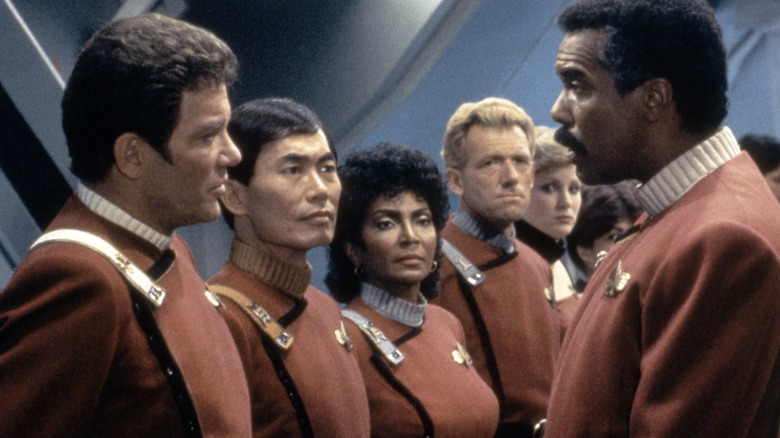
"Star Trek" is definitely a technicolor wonderland of a show. That sense of eye-catching brilliance trickles down from the background scenery to the props used by each cast member, all the way to the uniforms the show's central crew wears as a part of their duties.
It's easy to notice that the crew of the Starship Enterprise wear tunics in varying shades. Those colors are quite important — they denote which job class each crew member belongs to. Those classes were devised by series creator Gene Roddenberry and costume designer William Ware Theiss, and are intended to resemble the classifications used by the United States Military on noise-heavy aircraft carriers.
Sometimes there are differences allowed for dress uniforms; the command staff, for instance, will wear green uniforms during formal occasions. And these rules aren't hard and fast ones; across the whole universe of "Star Trek" series, films, and other ephemera, the colors various officers wear on the show and the meanings behind them change depending on when the scene takes place in the show's general timeline. But these are the color codes that most often denote each character's job on the ship, and the ones used during the original "Star Trek" series to explain who is who and what they do.

The term 'red shirt' gained a negative connotation
Even if you're not a "Star Trek" fan, you've probably heard jokes about how often red-shirted officers are introduced to the show, only for them to quickly die during away missions. For a period of time, the term "red shirt" became a dirty word in the "Star Trek" world; it's gone on to take on a larger cultural significance, indicating that a person is a disposable background element easy to get rid of. And yet many of the show's red-toting characters are the franchise's longest-lasting individuals. The class encompasses the engineering, security, and communication staff positions on the Enterprise. Lt. Nyota Uhura (Nichelle Nichols) and Montgomery "Scotty" Scott (James Doohan) are among the most prominent crew members who wear scarlet hues. To wear red on the bridge is definitely a high honor.
Are 'red shirts' more doomed than their counterparts? Mathematician James Grime weighed in on the subject during a talk at New York's Museum of Mathematics in 2017. A simple statistical calculation revealed that 10% of the show's red-shirted denizens die during the original show's run — compared to 18 percent of golden-shirted characters. "There is some truth in the old 'Star Trek' myth if you look at security officers ... 20 percent of security officers died. So I think the moral of the story is, if you're on the starship Enterprise and you want to survive, be a scientist," he said.
Ironically, crimson red was eventually used to denote a position of authority on the ship; the uniforms that debuted in "Star Trek II: The Wrath of Khan" place the crew in scarlet togs, with no color divisions to mark them.
Blue denotes a scientific mind
If you're feeling blue during your time on the Enterprise, then you're probably logically-minded. Throughout much of the original "Star Trek" series, blue uniforms were given to the show's science and medical officers. That's why Spock (Leonard Nimoy), Nurse Christine Chapel (Majel Barrett), and Dr. Leonard "Bones" McCoy (DeForest Kelley) can be seen sporting blue tunics throughout the series' run. The designation of blue uniforms hasn't changed much during the course of various "Star Trek" series; blue and purple shades are used to indicate ship medics in such continuations of the universe as "Star Trek: The Next Generation."
Blue was also the chosen shade for the crew uniforms in "Star Trek: The Motion Picture," with splashes of brown, oatmeal and white. This change didn't go over well with the cast. Their rebellion against the baggy uniforms went beyond their alleged unsightliness; costume designer Robert Fletcher sewed shoes into the bottom of each uniform, forcing the actors to ask their assistants for help in completing simple tasks such as going to the bathroom. A change was promptly made for the next film, and the red Navy-style uniforms stuck with the whole movie franchise until "Star Trek: The Next Generation" was launched.
Golden shirts denote power
Captain James T. Kirk (William Shatner), meanwhile, sports a gold-colored shirt. These are the outfits worn by those in command: largely, captains and other figures of authority. In other iterations of the show, gold tunics are worn by members of the ship's security staff. In any event, it's a uniform that denotes power.
But those shirts weren't actually intended to be golden at all; in reality, they were pale green tunics that were filmed as golden or orange-looking thanks to the sort of film the show used. According to an interview conducted with Bill Thiess in 1988 for Star Trek Prop Authority , it wasn't the show's intent to present Kirk and other captains as wearing gold at all. "It was one of those film stock things; it photographed one way – burnt orange or a gold. But in reality was another; the command shirts were definitely green." Unfortunately, thanks to that mistake the look has stuck, and Kirk's uniform is more often remembered as golden instead of green.
Whether they're sporting green or dodging danger in red, there's one thing officers on the Enterprise definitely know how to do – look stylish in a timelessly classical way.
Star Trek Uniforms Fully Explained
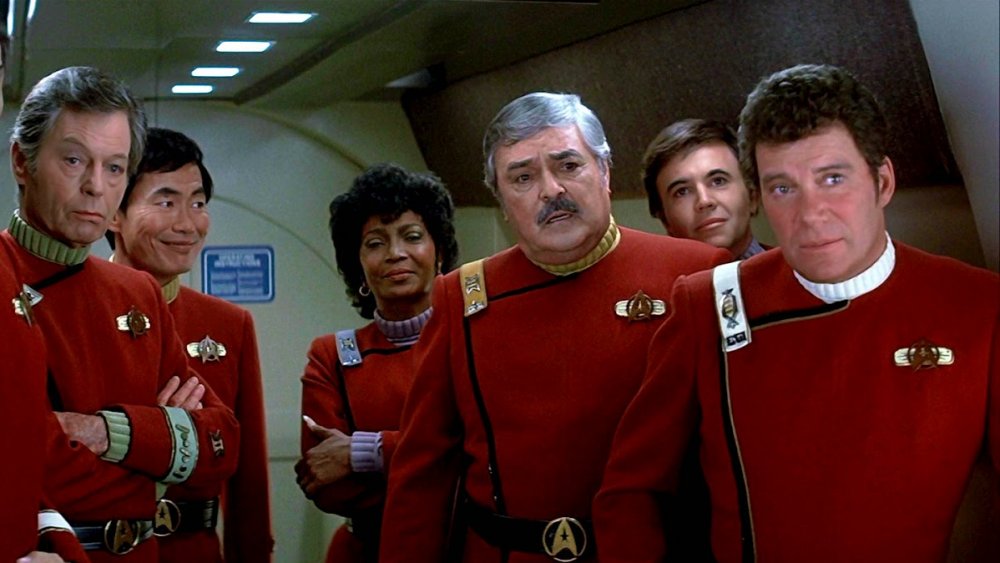
Since its premiere more than 50 years ago, Star Trek has been at the center of a growing web of culture, television, film, and fandom. With nine television series and 13 films, with undoubtedly more to come, there is a wealth of material to analyze and enjoy. Today, an enthusiastic fan can take just a single aspect of the Star Trek universe and dive into it for weeks.
Take uniforms. A seemingly simple concept, right? Star Trek generally focuses on the experiences of people serving in Starfleet, essentially a futuristic version of the Navy in space. So, Starfleet uniforms should be fairly consistent, even boring. Everyone's supposed to look like a cohesive group, so there should be little variation.
However, the uniforms of Star Trek are so varied and connected to the intricate fictional world of the franchise that it's pretty fascinating. Someone appearing on Star Trek: The Next Generation and then showing up again in a film like Star Trek: First Contact will probably have to fit themselves into two very distinct outfits. With more than five decades of stuff to go through, says CNET , there's a dizzying variety of looks for what's supposed to be a pretty staid quasi-military organization.
Practically everything about the history of Star Trek uniforms is linked to behind-the-scenes stories, real-world creativity, in-universe drama, and even a touch of fashion history here and there. From color, to cut, to material, there's a lot to learn.
Color is key to Star Trek uniforms
In Star Trek: The Original Series , which ran from 1966 to 1969, you can't miss the brightly hued uniform shirts sported by the crew of the starship Enterprise . Captain James T. Kirk and other members of the command staff sport golden yellow tops, says Mental Floss . Blue is reserved for the science department and medical personnel, so you'll see it on Mr. Spock, the second-in-command, and the ship's physician, Doctor McCoy.
And what of the folk in red uniforms? According to Star Trek lore, these poor "redshirts" are little more than cannon fodder, though, officially, red is for communications, admin, and security. If you're watching an episode where a random, red-clad crewmember is asked to beam down to the planet with the main cast, don't get too attached. They're probably going to get zapped, eaten, or otherwise annihilated to further the episode's plot.
Of course, there are some exceptions. Statistically speaking, says Nerdist , redshirts are not that bad off. Consider also that red shirts adorn major characters like Scotty, the ship's chief engineer, who made it through the entire series.
Now that you've got that settled, remember that it's only good for one series. In later Star Trek shows, red and gold switched places. Captains like The Next Generation 's Jean-Luc Picard wore a dark red, while his security chief, Worf, wore gold.
Starfleet rank is shown by pips and stripes
Like so many real-world military organizations, Starfleet hinges on rank. Crewmembers are expected to follow orders, but on starships that can carry thousands of people, who are they supposed to take seriously? That's where the rickrack comes in.
In Star Trek: The Original Series , rank was denoted by stripes of gold ribbon on someone's sleeves. The more stripes, the higher the rank. Generally speaking, says Atlas Obscura , two or three stripes means a captain. Commissioned officers are a safe bet for one stripe. Non-commissioned people get either a bit of braid or nothing at all. The stripes were brought back for the reboot films beginning in 2009.
The follow up series, Star Trek: The Next Generation went for something different during its 1987 – 1994 run. The colors became a more muted, and the old rank stripes, which, frankly, looked like something you might have picked up from your local craft store, were retired. In their place, officers wore "pips," subtle little pins, on their collars. The higher someone's rank, the more pips they sported.
Other films played around a bit with the rank symbols, like the different colors and badges shown in 1982's Star Trek II: The Wrath of Khan . Still, they weren't too off the original mark. Generally speaking, the more junk on someone's uniform, the more likely it is that you'll have to follow their orders.
The original series went for velour
Futurama 's Zapp Brannigan character, a send-up of Captain Kirk, is all about his velour uniform. The first Star Trek series really was into luxurious velour, too, but the fabric proved challenging to maintain. It's not as if the 1960s were known for comfortable natural materials, after all.
According to Esquire , the fabric initially used in Star Trek: The Original Series was a little flashy. Costume designers used a stretch cotton velour for the tops, with a black synthetic Dacron infused with sparkles for the pants. Both materials were meant to subtly glitter under studio lights, lending the uniforms a shimmery, 23rd-century, spacefaring feel.
Unfortunately, the velour was a flop. Many called it "that rotten velour," noting that the fabric tended to shrink in the wash and could tear easily. In the third and final season, designers substituted it for a double-knit nylon, says CNET , which proved to be a much hardier fabric, especially when it got thrown into the washing machine.
Captain Kirk's special green shirt was a little embarrassing
Originally, reports Atlas Obscura , the command staff of Star Trek: The Original Series was supposed to be sporting a muted green. Under the studio lights, though, the cameras read the green velour as a golden yellow. The production team simply went with it for the rest of the series.
Careful observers of the 1960s run will note that Captain Kirk is sometimes seen in a very green tunic-style shirt. According to an interview with series costume designer Bill Theiss , that's because it was made out of a different material. That particular shirt looked genuinely green. This is also why some of the colors in the original series seem to change, said Theiss. Even the miniature of the Enterprise could appear ever so slightly green under the right conditions.
William Shatner, the Canadian actor who played Kirk, wasn't necessarily fond of the tightly wrapped look, says Cinemablend . "It was a little embarrassing after lunch to have that tight green thing on you," he said.
Star Trek's women went from pants to miniskirts
The first pilot episode of Star Trek: The Original Series , " The Cage " is an odd duck. Though it was shot in 1964, it didn't make it to screens in its complete form until a Betamax release in 1989. Bits of the story were included in the season one two-parter "The Menagerie," but it contained only the briefest glimpses of what might have been.
These included things like a smiling Spock, different uniforms, and a woman in command wearing pants . Star Trek: The Original Series is notorious for its gendered uniforms. The men wore pants and long-sleeved shirts. Female crewmembers were confined to miniskirts so short that Lieutenant Uhura, the communications officer, always seemed on the verge of an embarrassing situation when she sat down.
That's partially why Number One, the second-in-command in "The Cage," stands out: She's wearing pants. Number One, played by Majel Barrett, is also a daring commander. But she wasn't considered right for the character. When Star Trek got its second pilot, none of the women were in command, and certainly none of them wore pants. Barrett returned, albeit as the emotional, mini-skirted Nurse Chapel.
Nichelle Nichols, who played Uhura, offers up a counterpoint. "I was wearing [miniskirts] on the street," she told the BBC . "What's wrong with wearing them on the air? [...] It was the era of the miniskirt. Everybody wore miniskirts."
The first Star Trek movie shook took uniforms in a weird direction
Star Trek: The Motion Picture looked like it was going to be a big deal. The 1979 film was the first time that fans would get to see their beloved crew on the big screen. Anticipation was high. Then, the movie debuted.
It landed with a dull thud. While die-hard fans still got enjoyment out of Star Trek 's film debut, most viewers couldn't get past the plodding story and dialogue-heavy scenes. It made just enough profit to justify a sequel, to be sure. SyFy contends that The Motion Picture did originate some interesting new trends for the franchise, like wearable communicators and redesigned Klingons . Still, few would point to this entry as their favorite Star Trek movie.
Some of the blame surely lies with the redesigned uniforms. Where The Original Series had colorful, if somewhat cartoonish togs for the crew, The Motion Picture made it look like everyone was going to the weirdest slumber party ever. According to Memory Alpha , the crew was now outfitted in two-piece tunics and one-piece jumpsuits in mind-numbing shades like pale blue and beige. At least the women on the crew were dressed in the same jumpsuits worn by the men. They might have looked oddly dull for space adventurers, but crewmembers like Lt. Uhura didn't look like they needed to worry about errant breezes. And, if nothing else, the space pajamas look pretty comfortable.
The Wrath of Khan redeemed Star Trek uniforms while cutting costs
Though Star Trek: The Motion Picture began the series tradition of changing Starfleet uniforms at every opportunity, rebooted uniforms didn't get very eye-catching until the second film. In Star Trek: The Wrath of Khan, both the plotting and the uniforms got a much-needed upgrade.
To be fair, the striking red jackets of The Wrath of Khan wouldn't have existed as we know them if it weren't for the beige jumpsuits of The Motion Picture . As revealed by Empire , costume designer Robert Fletcher, burned somewhat by his experiences on the first film, decided to stay on in an attempt to redeem his craft. Fletcher still had to work within budget, says Forgotten Trek . Indeed, the budget was smaller, since the studio had been spooked somewhat by the lackluster performance of the first motion picture. As a result, Fletcher rather cleverly utilized the old movie uniforms. His team dyed the tunics red because that was the shade that took best to the fabric.
Meanwhile, Fletcher added a few more militaristic details to the revamped uniforms, like boxy shoulders, stripes, and shiny rank insignia. Fletch referred to it as "Hornblower in outer space," referring to the popular Horatio Hornblower series, set in the era of the Napoleonic Wars. The maroon color proved so successful that it persisted far beyond the film and back onto television with the follow-up series, Star Trek: The Next Generation.
Star Trek: The Next Generation's uniform was all about spandex
While the uniforms debuted in Star Trek: The Wrath of Khan were structured, boxy outfits inspired by military getups, the theme wasn't going to last, for William Ware Theiss, who designed the costumes for Star Trek: The Original Series , was ready to completely revamp even his own designs. Theiss was called upon to design the costumes for the first year of Star Trek: The Next Generation , the follow-up series that premiered in 1987. According to Forgotten Trek , Theiss wanted to pull back from the structured look of Wrath of Khan and return to a softer appearance.
That meant spandex. Specifically, Theiss employed a heavyweight material, of the type often used for swimsuits. He also changed the color scheme, making red the color for command staff, while gold was switched to engineering and security. Blue remained the key shade for medical and science personnel.
While designers might have liked the spandex, it got poor reviews from the actors. The form-fitting material was unforgiving of a heavy lunch or brief dalliance with a slice of cake. Robert Blackman, who replaced Theiss in later seasons, came to the rescue with a different cut and wool fabric. Unfortunately, only the male actors got the best changes, like two-piece uniforms. Female actors like Marina Sirtis, who played Counselor Troi, were stuck in uncomfortable one-piece jumpsuits for a while longer.
Deanna Troi's exception confused Trek fans
In Star Trek: The Next Generation , ship's counselor Deanna Troi was actually a Starfleet officer, but you wouldn't know it from her clothes. While everyone else on staff was wearing the regulation Starfleet uniform, Troi was often stuck in revealing onesies that recalled the first film's unfortunate jumpsuits.
It may have something to do with Troi's gender. As quoted at Forgotten Trek , Marina Sirtis, who played Troi, took a dim view of how the show treated female characters. "The women on this show are very non-threatening," she said. "You don't see women in power positions." Troi was meant to be a soft, caring therapist. Perhaps her clothing was meant to reflect that gentleness, but with an admittedly sexist twist that lowered her necklines and kept Sirtis trapped in revealing spandex for much longer than her coworkers. Too often, her clothes reflected stories where Troi was made to be helpless or even outright dull for the sake of the plot.
Counselor Troi finally got to wear the real uniform in "Chain of Command, Part 1," a season six two-parter. In it, Captain Jellico, an uptight fill-in for Captain Picard, curtly tells Troi to just wear the uniform already. While the impetus for the wardrobe change might have been embarrassing for her character, Sirtis was delighted. As she told the BBC , "I was thrilled when I got my regulation Starfleet uniform [...] I got all my brains back."
The "skant" tried to reach gender equality but fell flat
We should give Gene Roddenberry some credit. While he was often of his time for things like scantily clad secondary characters on Star Trek: The Original Series , he genuinely tried to push back against cultural assumptions. Sometimes, it worked and became practically legendary, as when he helped to create a diverse bridge crew on the first television series. Other times, he pushed for costume parity that simply didn't land.
Roddenberry was involved with the production of Star Trek: The Next Generation from its 1987 premiere until shortly before his death in 1991. He was part of almost everything in the series, including the costume design. As reported by Star Trek.com , Roddenberry directed designer William Ware Theiss to design what became known as the "skant."
This take on the minidress was made out of the same spandex as the other uniforms. It was also meant to be unisex. Crewmembers of any gender would be able to wear the thigh-baring skant. Yet, it was a hard sell. The skant was ever-so-briefly seen on a male crewmember here and there in the first season, says SyFy, but never after that. Female crew like Counselor Troi wore it a bit longer, but actors and viewers alike thought it just made her look like a space cheerleader. Though you can understand what Roddenberry and company were going for, the skant just couldn't stay. It faded into fan lore and obscurity soon after the first season.
Star Trek: Deep Space Nine made the uniforms fit for actual work
Star Trek didn't stop with Star Trek: The Next Generation . The sequel series was followed up by a progression of films and further television series. These included Star Trek: Deep Space Nine , which premiered in 1993 and briefly ran concurrently with The Next Generation . Though both series are supposed to take place at roughly the same time, the uniforms seen on Deep Space Nine were a serious departure.
Costume designer Robert Blackman returned to the jumpsuit design but mercifully stayed clear of figure-hugging, back-breaking spandex, says Forgotten Trek . Instead, the looser jumpsuits were made out of wool. Blackman had, like earlier designers, discovered that wool took dye better than other fabrics and held up to repeated washings.
The softer uniforms looked like they could exist in a real, workaday reality. Characters like Chief O'Brien can be seen in the bowels of Deep Space Nine, a scrappy space station inherited from its previous Cardassian occupants. His jumpsuit, based in part on a mechanic's outfit and NASA workaday gear, looks right at place in the more gritty, realistic world of Deep Space Nine .
Star Trek: Lower Decks brings back color and might explain a big mystery
Star Trek: Lower Decks is an animated comedy series, the first ever to take a look at the ridiculous side of Star Trek . While it's very definitely a silly take on the franchise, the Lower Decks series actually holds a clue to the ever-changing and seemingly inconsistent uniforms across the series.
In part, the uniforms of Lower Decks are an homage to a never-used 1994 redesign. According to Trek Movie , creator Mike McMahan realized the discarded uniform design for the Star Trek: Generations movie was just right for his series. It calls back to The Next Generation just enough to make connections but remains distinct and colorful in its new two-dimensional context.
This latest series might also help explain the constantly shifting Starfleet uniforms. Careful viewers may have already noticed that different ship and station crews sport wildly different looks, even when they're supposed to be taking place at the same time.
Inverse points out the apparent fact that Starfleet uniforms seem to correspond to very specific ships and jobs. Someone sent to a space station like Deep Space Nine would wear one uniform, while another crewmember on Picard's Enterprise would sport something noticeably different. An outside viewer could still see they were Starfleet personnel but might correctly guess they were stationed in different places. The looks on Lower Decks , which are their own unique creations, add more evidence to support this theory.
- Celebrities
- Secret Invasion
- The Marvels
- Disney Plus
- Apple TV Plus
- Dwayne Johnson
- Brie Larson
- Ryan Reynolds
- The Witcher
- About & Advertising
- Affiliate Policy
- Privacy Policy
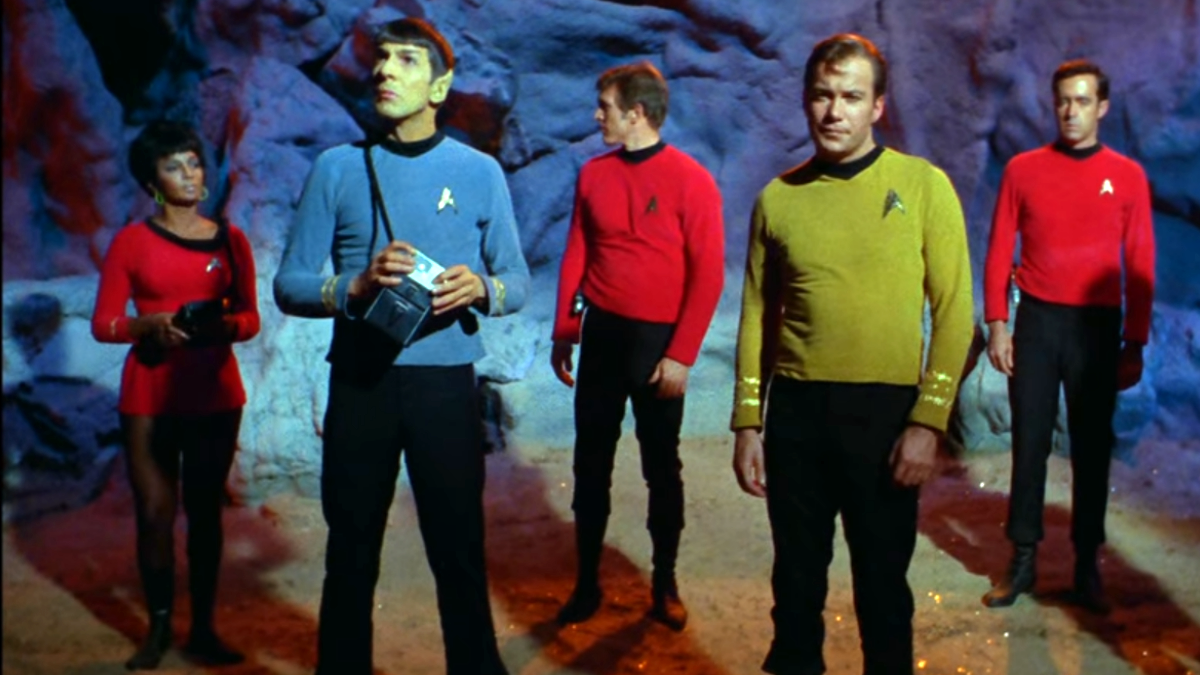
‘Star Trek’ uniform colors, explained
Everyone knows the iconic Star Trek uniforms. The brightly-colored outfits amazed viewers seeing color TV for the first time in the 1960s and helped to define the unique aesthetic style of the Star Trek universe, becoming an instantly recognizable feature of the shows.
The 23rd Century
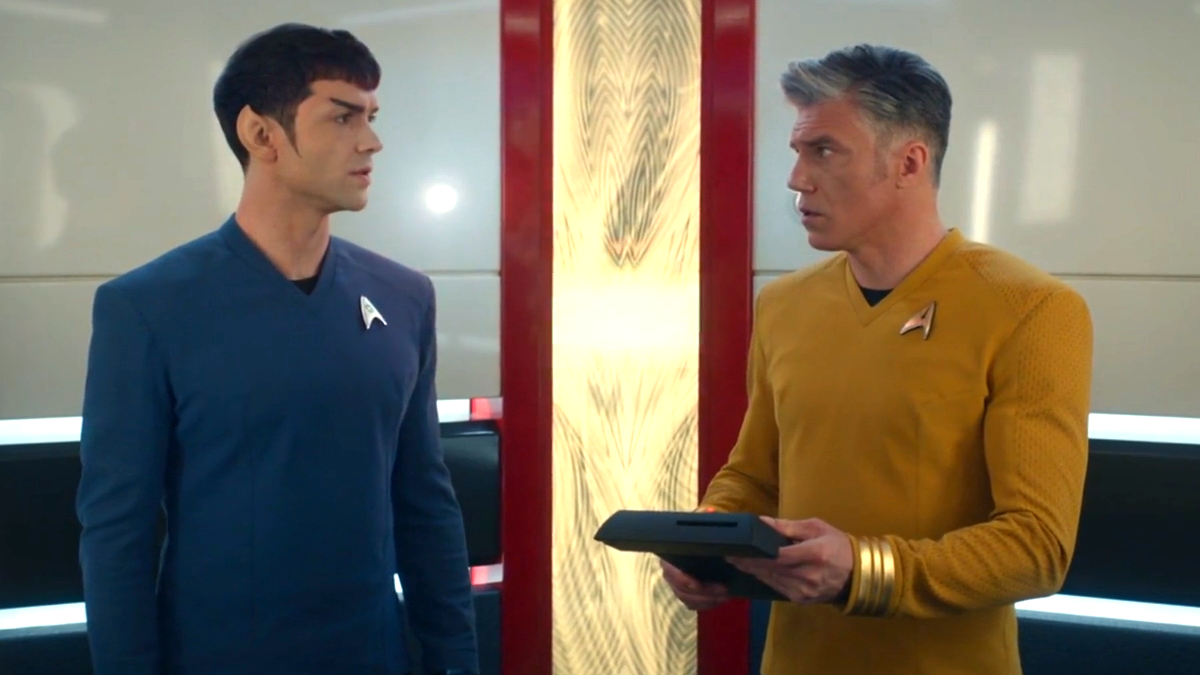
In The Original Series , there were three uniform colors . Each color represented a certain duty division aboard a starship or station. Gold, as worn by Kirk and Sulu, denoted the command division of Starfleet, which included most ranking officers and administrative personnel. Blue, as worn by Spock and McCoy, denoted the sciences division. This included researchers and medical staff. Red, as worn by Uhura and Scotty, denoted the operations division which covered a wide range of specializations such as engineering and security. Each color choice was bold and striking, meaning viewers could immediately tell what position any new character had in Starfleet.
The Original Series gave rise to the infamous phenomenon of “redshirts.” Security officers wore red shirts and would regularly put themselves in harm’s way. Enterprise crew clad in red were massively more likely to be killed than their counterparts in the other divisions. A redshirt’s life could be painful and short — they would be blown up by alien weaponry, plunge head-first into bottomless chasms, or even have all their red blood cells surgically removed by malevolent cloud creatures. Around 26 officers in red uniforms died during the course of the series’ three-year run. In the season two episode “ The Apple ,” four unfortunate redshirts are killed navigating a jungle deathtrap, being struck by lightning, shot by plants, and falling onto landmines. Even by the cruel standards of the show, this ranks as a bloodbath.
Strange New Worlds — set very shortly before The Original Series — keeps the same uniform colors, but adds a new one. A white uniform denotes someone working as a member of medical staff, but these were seemingly phased out in favor of standard blue uniforms by the time of The Original Series .
Star Trek: Discovery , a prequel series set a little further prior to The Original Series , introduced a new color-coding system. All uniforms were made of dark blue fabric, with division denoted by metallic stripes on the shoulders. These stripes were gold (command), silver (sciences), and copper (operations). These clothes were super-sleek but looked too much like Navy uniforms, and it could be hard to tell at a glance who was part of what division.
The 24th Century
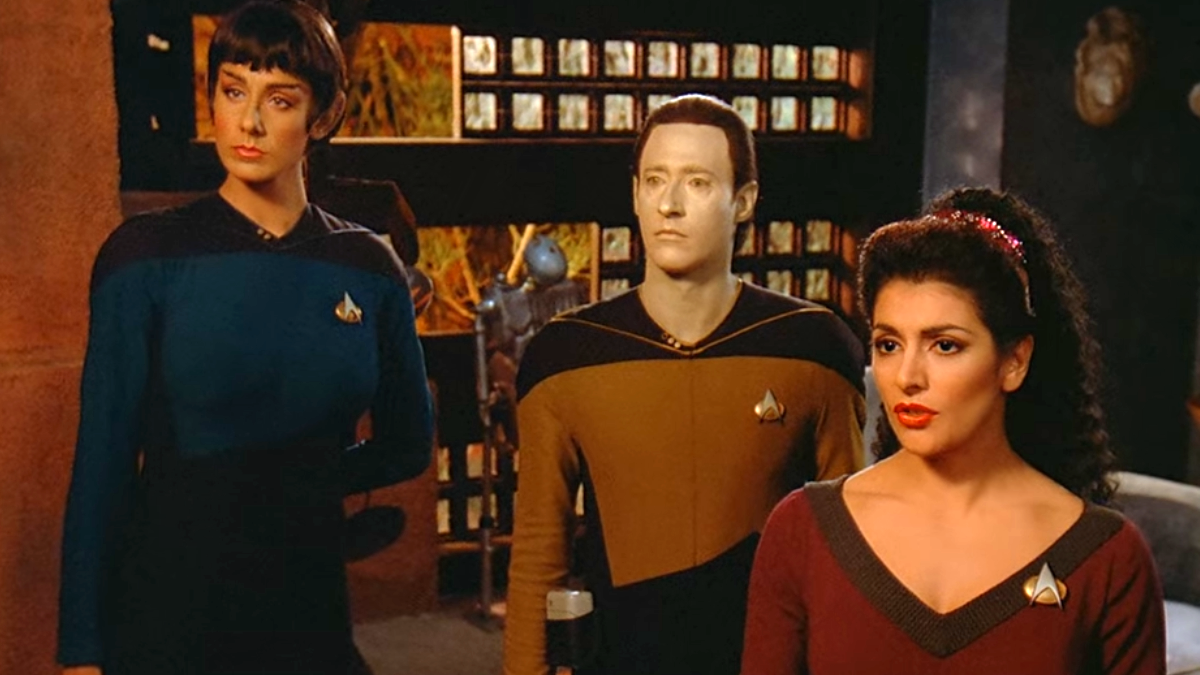
By The Next Generation , the uniform colors had changed . While blue still denoted science and medical, the meanings of red and gold were inverted. No reason was ever given in-universe for this, but the real-world explanation is that Next Generation actors looked better in certain colors — Brent Spiner as Data, for example, was deemed to look far better in gold than in red or blue. The change also came partly as a result of the Star Trek movies of the 1980s, where all Starfleet personnel were shown to wear red uniforms (the fabric for the costumes took better to red dye). Kirk had been seen wearing red for the movies, so it was felt that audiences would come to associate red with command.
Whatever the century, series, or ship, Star Trek just wouldn’t be the same without everyone clad in brightly colored pajamas. Too many modern science fiction shows have their actors wear drab, dark, soulless uniforms. Strange New World s is proudly carrying on the multi-colored tradition set way back in 1966.
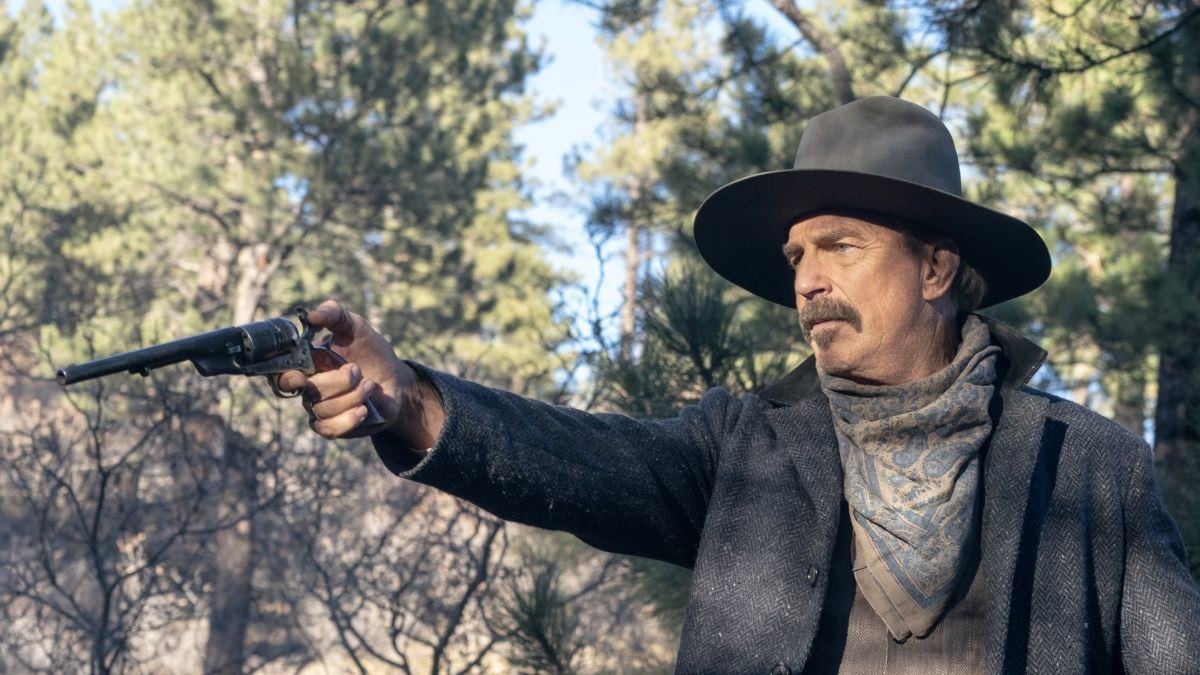
What Do the Different Uniform Colors Mean on ‘Star Trek’?
By jason serafino | mar 30, 2023, 3:23 pm edt.
Gene Roddenberry may have dreamed of a perfect future when he created Star Trek , but parts of his vision were firmly rooted in the real world, specifically in the physical makeup of the crew of the Enterprise itself.
Roddenberry, along with the show’s producers, decided to take numerous cues from the United States Navy when creating the official ranks on the show, including a captain overseeing a crew made up of a commander, a handful of lieutenant commanders, lieutenants, and several subordinate roles. But it’s the different colors of the Starfleet uniforms that really tell the story of how the Enterprise operates.
Fans know the basics: an array of blue, red, and gold shirts line the bridge of the ship every episode. Those colors weren’t just randomly picked for the sake of diversity, though. They actually correspond to the ship’s various service roles . The gold shirts are worn by the command division, which includes Captain Kirk, Lieutenant Sulu, and Pavel Chekov. Red uniforms belong to the engineering/communications division, including chief engineer Scotty and communications officer Uhura. The blue shirts are worn by the science/medical staff, including McCoy and Spock .
As with everything in Star Trek , though, it’s a lot more complicated than all of that. In addition to the red shirts belonging to engineers and communications personnel, they are also assigned to the security division. What’s the purpose of the security division on the Enterprise ? Well, they’re usually the supporting characters who are immediately killed whenever the crew is confronted by a new enemy. This is something of a running gag for fans of the franchise, as whenever one of the “Red Shirts” is seen on screen, you know they’re not long for this world .
Also, those gold shirts worn by Kirk and crew might not have been so gold after all. According to an interview with Star Trek ’s costume designer, William Theiss, the idea was for the show’s uniforms to be red, blue, and green. In fact, on the set, Kirk’s outfit certainly looked to be an avocado (or lime) green, but the end result was a little different when the studio lights finally hit the uniform.
“It was one of those film stock things,” Theiss said, “it photographed one way—burnt orange or a gold. But in reality was another; the command shirts were definitely green.”
This might come as a surprise to Trek fans until you remember that Kirk actually did wear green on a few occasions, including the times he was in formal dress and his seldom-seen alternate green get-up, seen in the clip below.
These alternate uniforms were all the exact shade of green Theiss describes, but they were made from a different material than the standard Enterprise shirts and apparently had no issue retaining their natural color scheme when lit on set. The gold shade may have been a production mishap, but the color has since entered the Trek canon as the official hue of Kirk and his command staff. So, in the Star Trek universe, Kirk wears gold; in the real world, though, the bridge of the Enterprise was designed with a completely different color palette in mind.
It gets more confusing when you look at the later Trek series, like The Next Generation , which had the command staff in red and operations in yellow—basically the reverse of the original series. Then, of course, the movies switched costumes and colors with nearly every entry, including the powder blue monstrosities worn in Star Trek: The Motion Picture .
Roddenberry’s eye for detail was unique for sci-fi TV at the time, and everything on the Enterprise had a specific purpose. Despite some production fumbles, ill-fated redesigns, and inconsistencies later on, the colors that make up Starfleet’s uniforms tell a story that many viewers probably never even noticed.
A version of this story originally ran in 2016; it has been updated for 2023.
Screen Rant
Star trek: every starfleet uniform & history explained.

Your changes have been saved
Email Is sent
Please verify your email address.
You’ve reached your account maximum for followed topics.
Star Trek’s Starfleet Uniform Colors: What They Mean & Why They Changed
After 57 years, star trek settles the truth about trelane's godlike species, every star trek character killed by ron moore.
Star Trek's utopian idealism may be eternal, but Starfleet's fashion sense is in seemingly constant flux. Virtually every iteration of the franchise has featured a new uniform for its Starfleet heroes. Sometimes they come off more like superhero costumes, sometimes they seem like strict military wear, and many other times they're somewhere in between. From Captain Kirk's gold tunic to the sleek blue body suits of Star Trek: Discovery , there's no shortage of iconic Starfleet uniforms.
There's rarely an in-universe reason given for the constant costume changes in Star Trek , though the real world reason has always been to keep the franchise looking fresh and sleek, and often to echo real world fashion sense, as well as trends in sci-fi costuming. Gene Roddenberry's original vision for Star Trek has gradually evolved as the series has grown and developed — it's only natural that the look of the franchise, including the iconic Starfleet uniforms, would change as well.
Related: How New Star Trek Shows Avoid A Classic Voyager Trope
The following discussion is a rundown of the primary Starfleet uniforms only; there are scores of variations, like dress uniforms, admiral uniforms, and away team gear. Bearing that in mind, these are all the iconic looks of the Starfleet uniform through the years.

Star Trek: Enterprise
As was appropriate for the prequel series about humanity's first forays into deep space, Star Trek: Enterprise featured economical, functional blue jumpsuits. Colored piping on the shoulders indicated which division each crew member was a part of - gold for command, red for operations, and blue for sciences. Rank insignia were displayed on the right shoulder, with an assignment badge on the left sleeve. Unusually for Star Trek uniforms, these featured plenty of 21st century details like zippers and pockets, sometimes making Captain Archer and crew look like the galaxy's most sophisticated janitors.
Star Trek (2009)
Featured briefly in the opening scene of J.J. Abrams first Star Trek film - with Thor's Chris Hemsworth as George Kirk - these uniforms were something of a middle ground between the look of Enterprise and Star Trek: The Original Series . The jumpsuits were now replaced by tight fitting spandex, but still in fairly muted colors, with blue for command, gold for operations, and grey for sciences. Rank insignia was displayed on the cuffs of the sleeves.
Related: Discovery Officially Makes J.J. Abrams' Star Trek Movies Canon
Star Trek: Discovery
A massive departure from what came before and what would follow, Discovery's all-blue uniforms featured a jacket and pants with striping down the sides, as well as chunky black boots. The striping on the shoulders indicated divisions - gold for command, silver for sciences, copper for operations - and the Starfleet badge worn on the right breast featured both a division symbol and rank pips. This uniform was in service at the same time as a slightly modified version of the classic TOS uniform.
Star Trek: The Original Series
Perhaps the most iconic uniforms in all of Star Trek , The Original Series' uniforms were also perhaps the simplest. These uniforms consisted of a colorful tunic, black undershirt and black pants with black boots. Command classes wore either gold or green tunics, operations wore bright red, and sciences utilized a baby blue. Rank was displayed on the cuffs of the sleeves. This uniform also offered numerous slight variations, like Dr. McCoy's short sleeves and Captain Kirks' wraparound tunic, while most female crew members wore a skirt variation.
Star Trek: The Motion Picture
A completely new look was introduced in Star Trek: The Motion Picture . Gone were the colorful tunics of TOS , replaced by muted jumpsuits in Star Trek: The Motion Picture 's polarizing big screen debut . The variations are almost too numerous to list, but the basic look was a jumpsuit that was either blue, white, or beige, with division patch attached to the chest. The uniform also featured a life support belt, and shoes that were integrated into the trousers, creating some unfortunate footie pajama comparisons. The Motion Picture would be the only Star Trek project to utilize this style of uniform.
Star Trek: The Wrath of Khan
Star Trek: The Wrath of Khan would introduce one of the longest-lived uniforms in Starfleet history. These uniforms consisted of a red jacket, white long sleeved turtleneck and black pants with red piping. It also featured the now-iconic Starfleet insignia on the left breast, as well as new rank insignia on the right shoulder. Minor variations of this uniform would be used for all of the remaining TOS cast films, and even featured in some Star Trek: The Next Generation flashbacks and time travel stories.
Related: Star Trek: Every Mirror Universe Episode
Star Trek: The Next Generation (Version 1)
The debut of Star Trek: The Next Generation saw the next radical reinvention of the Starfleet uniform. The uniform featured a streamlined jumpsuit design, with the pants and shoulders in black, and the torso either red for command, gold for operations, or blue for sciences. The rank insignia were displayed on the collarbone. The Starfleet combadge made its debut with this uniform - the Starfleet insignia doubled as a communication device. The TNG cast infamously hated the spandex costumes, as the way they were designed caused several cast members to have back problems, and they'd be redesigned for the show's third season.
Star Trek: The Next Generation (Version 2)
Featured during seasons 3-7 of Star Trek: The Next Generation , this is perhaps the second most iconic Starfleet uniform after the colorful tunics of The Original Series . The tight bodysuit look was left behind for a gaberdine material, with raised collars and solid black belts added to the look. The rank insignia were moved up to the collar, and the shoulder piping removed. Captain Picard would wear a variation of this uniform in later seasons that featured a grey sweatshirt and a jacket with the two-toned pattern.
Related: Star Trek Reveals The Federation Knows What Happened To TOS' Spock
Star Trek: Deep Space Nine
Deep Space Nine ditched the formality of the TNG uniforms for something darker and more utilitarian. These uniforms were largely black jumpsuits, with only the shoulders in red for command, gold for operations, and blue for sciences. The Starfleet delta symbol was slightly updated, changing the back piece from an oval to a buckle shape. A grey undershirt was utilized, and it wasn't uncommon to see officers with their sleeves rolled up, something of a visual cue to the grittier, grimier stories DS9 intended to tell. And while tonally different, Star Trek: Voyager would use this uniform for its entire seven year run.
Star Trek: First Contact
The next major evolution of the Starfleet uniform, this version kept the basic shape of the TNG -era uniforms, though with new color variations. The uniform consisted of black pants and a black and grey jacket, with a colored shirt underneath to signify divisions, once again going with red for command, gold for operations, and blue for sciences. The rank insignia remained on the collar, though they were also added to the cuffs.
Related: Star Trek: The Kelvin Borg Ruined Picard's Most Iconic Moment
Star Trek: Lower Decks
Utilized concurrently with the uniforms introduced in First Contact - as seen during the first season finale's heroic USS Titan moment - the Lower Decks uniforms are something of a middle ground between the look of the TNG movies and TNG the series. The division colors from TNG were maintained, though a new delta symbol with no backing was used. The uniform consisted of an angular dress shirt with black pants and boots.
Star Trek: Picard (Version 1)
The Starfleet uniforms featured in Star Trek: Picard's flashbacks were predominantly black with colored shoulders to indicate division, still utilizing the division colors established in TNG , and with the rank insignia still on the collar. The delta insignia first seen in Deep Space Nine and First Contact was still in use as a combadge.
Related: Star Trek Theory: Worf Replaces Data In Picard Season 2's Story
Star Trek: Picard (Version 2)
Extremely close to the look of the original DS9 uniforms, the Starfleet uniforms of Star Trek: Picard's relative present were, again, mostly black, with standard TNG division colors on the shoulders and collar. The delta symbol was updated to the version glimpsed in the possible future seen in the TNG series finale "All Good Things," and the rank insignia was moved to the chest.
Star Trek: Discovery Season 3
Star Trek: Discovery 's relocation to the 32nd century brought with it yet another new Starfleet uniform. This time the uniform is largely grey, with a stripe down the left side of the uniform signifying division - red for command, gold for operations, and blue for sciences, and white for medical. The combadge is now an oval shape, and is not only a communication device, but a holographic tricorder and personal transporter as well. The rank insignia are displayed on the combadge, while captains wore additional rank insignia on their shoulders.
Next: Star Trek: Every Major Character Who Died & Was Better For It
- SR Originals
- More to Explore
- Series & Movies
Published Mar 5, 2021
You Wear It Well: The Uniforms of Star Trek
Turns out, "dress for the job you want, not the job you have," might still be a phrase heard in the 23rd Century and beyond!
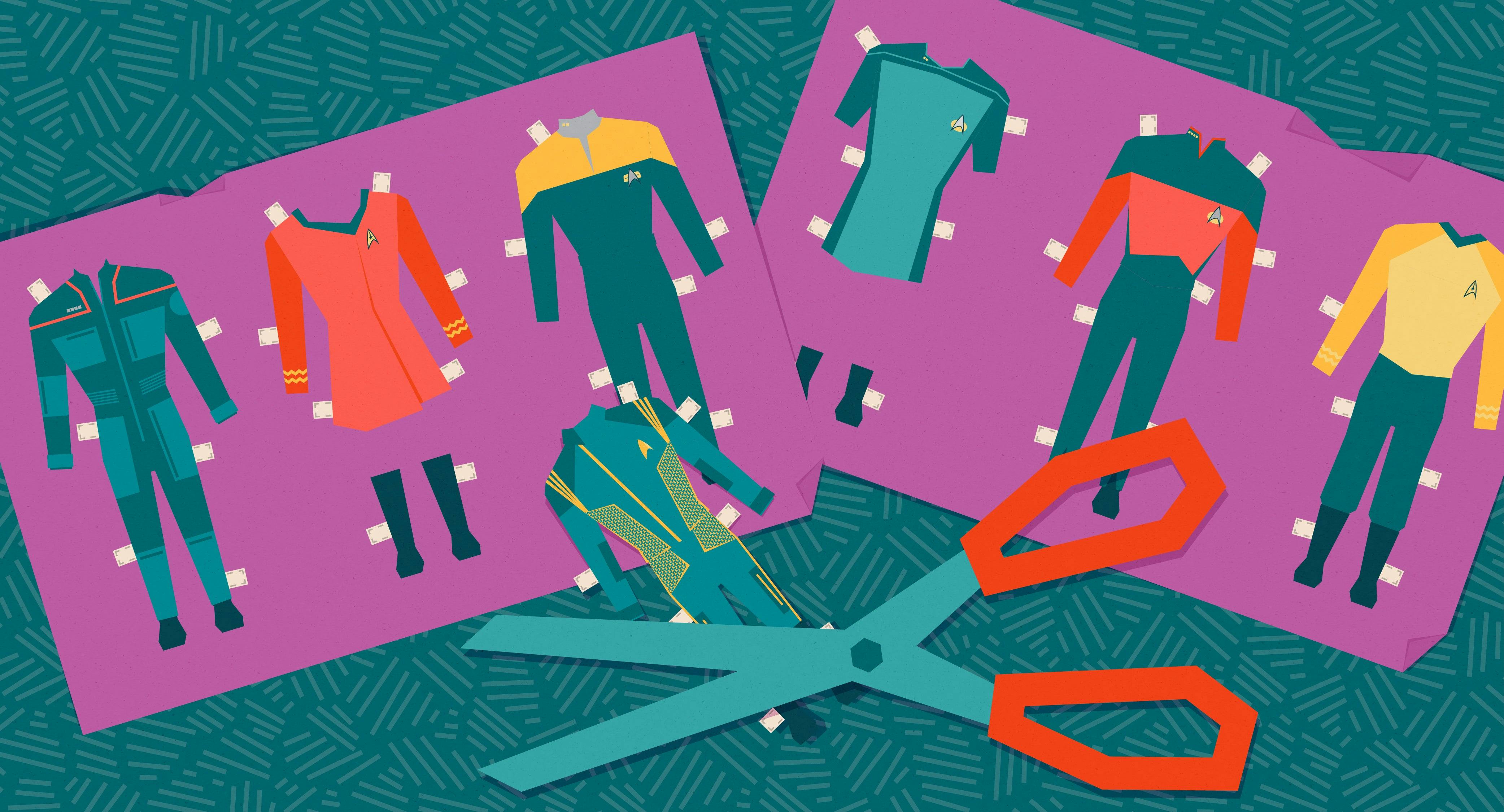
StarTrek.com
The Delta Shield. The colors: red, gold and blue. The form-fitting jackets and often black trousers. Even the confining jumpsuits. Star Trek uniforms have a special place in pop culture, equal in renown maybe only by the jerseys and full kits of certain sports teams. Let’s take a look at some of the uniforms over the years and what messages they are sending to the galaxy.
Star Trek: Discovery — Of Terran Capes And Crowns with Gersha Phillips
Star Trek: The Original Series

The TOS uniforms are arguable the most recognized and iconic of uniforms in the canon. They are the blueprint for all other uniforms in Star Trek . While they carry some of the elements from the “The Cage” unaired pilot episode — tunic-like top, Section colors, black capri-length trousers and boots — the cut and fit of the garments are narrower, the colors much sharper and for the women, no pants. Looking back from our vantage point the uniforms feel more inspired by the 1960s' mod culture, or the era’s British rock bands, not what a fleet of earth-based space explorers would be wearing in the 23rd Century. However, the athleisure vibe of it all was as portentous to our time as the TOS-inspired technology and gadgets that we use on a daily basis. Comparing these uniforms from the garments of other space traveling cultures seen throughout TOS is where you can really see the youthfulness of Starfleet. While Romulans’ uniforms echo the turtleneck silhouette, knit fabric and ultra miniskirts of Starfleet, the rigid textures, exaggerated shoulders, and the addition of a scarf or half vest overlays connotes a sense of the authoritarian militaristic society. Comparing the two looks, without context, you wouldn’t be at fault for easily assuming that Starfleet was the newest team in a galactic travel league.
Star Trek: The Next Generation

Star Trek: The Next Generation was all about the jumpsuit, with a touch of individuality. The best examples of this is Lieutenant Worf’s beautiful Klingon military sash or baldric and Lt. Troi’s flowing dresses and jumpsuits. The Next Generation also famously changed command colors from gold to red, ending a fan favorite “red shirt” trope from TOS. You see other examples of Starfleet uniform styles on the flagship Enterprise , including skants and tunics. The men’s TNG dress uniforms could even be worn as dresses due to their somewhat elongated line. However, from a design and storytelling point of view, the jumpsuit's utility is matched with the artful graphic design which evolves easily into the dress uniform’s elegance and formality.
Into the #Starchive Featuring Captain Picard's Uniform
We can see Starfleet’s evolution of mission and the number of lightyears traveled in the precision of the TNG uniform. Interestingly, the need to continuously mirror the delta design — in the shoulders, sleeves, even in the transition from bodice to trousers both section colors, front and back — is like a monogram. For the many species Jean-Luc Picard and his crew will make First Contact with, this uniform conveys a simple message: We are Starfleet.
Star Trek: Enterprise
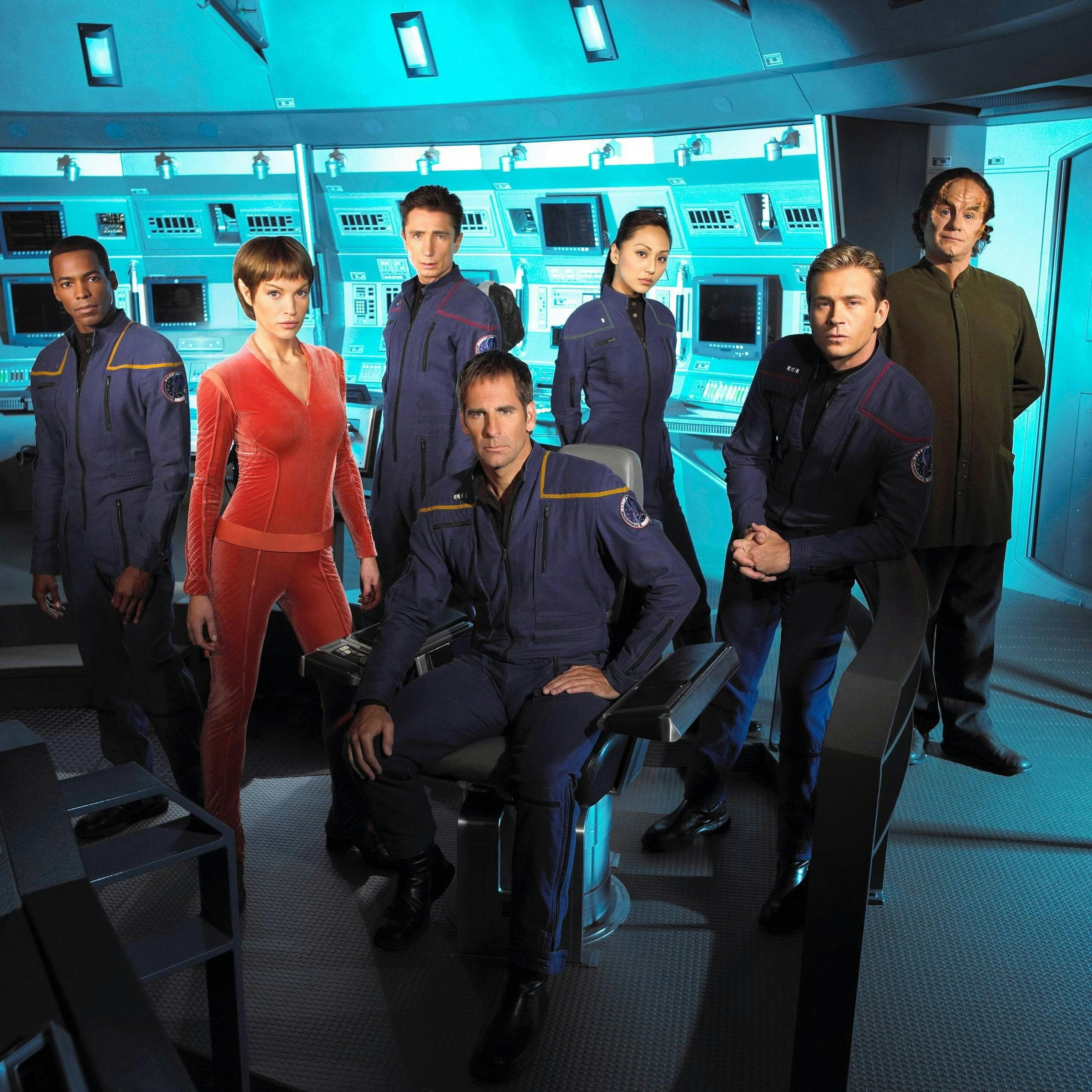
We cannot talk about jumpsuits without talking about Star Trek: Enterprise ! The uniforms on this series most closely represent what our beginnings of further flung space travel might look like. In fact, rather than trying to create something that feels brand new and “science fiction,” the Enterprise crew looks like a team from the National Aeronautics and Space Administration (NASA). The command colors are placed in a simple elegant line framing the shoulders ending, of course, in a point or delta shape. The jumpsuits have the wonderful addition of actual pockets, which actually makes you wonder where all the pockets have been all of this time. Hallelujah — there will be pockets in the future! The jumpsuits are reminiscent of a behind-the-scenes pit or union crew, workers who are laying the important foundation for the future. Yet, similar to workwear from the 20th Century, there is an elegance of how a non-gender specific garment function matches and enhances its form. A more advanced culture may be more fancily dressed, but no one can jump on a nacelle rigging faster than Charles “Trip” Tucker, III.
Star Trek: Deep Space Nine and Star Trek: Voyager
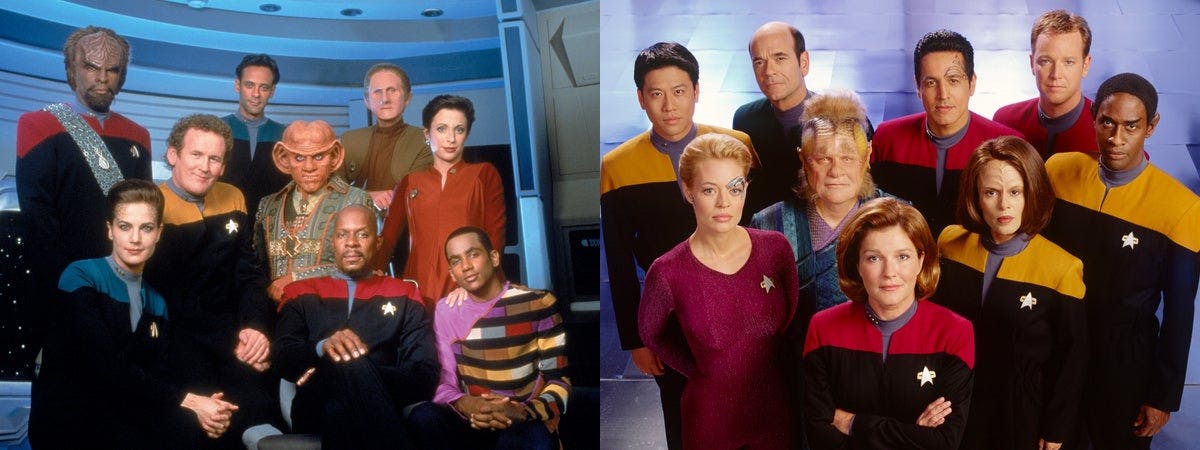
These series combine the streamlined look of the TNG jumpsuit with the function of Enterprise series jumpsuits — jackets, pockets, and pleated trousers. The colors: command red, operations gold, and sciences blue continue with the addition of a mock turtleneck undershirt in grey, which evolves later in a uniform variant where the section colors are the turtleneck and the upper bodice detailing is a quilted grey. Grey as a standard color for Starfleet uniforms appears in Star Trek: The Motion Picture and seen again in Star Trek: Discovery season 3, discussed below.
Into the #Starchive with Captain Janeway's OG Uniform
Deep Space Nine uniforms are particularly interesting in the way all clothes are, in relation to the places and people we associate these outfits with. What makes DS9 unique is the variety of dress everywhere on the starbase, from the Bajoran military uniforms with even more emphasis on the upper bodice and shoulders than Starfleet’s uniforms, to the regalia of the Bajoran monks.In the context of running a space station, Starfleet uniforms need to balance a message of both authority and hospitality. In a sea of colorful people and outfits on the space station’s promenade, the Starfeet uniforms’ relative dark color scheme is the easiest to recognize.
Star Trek: Discovery (Seasons 1-2)
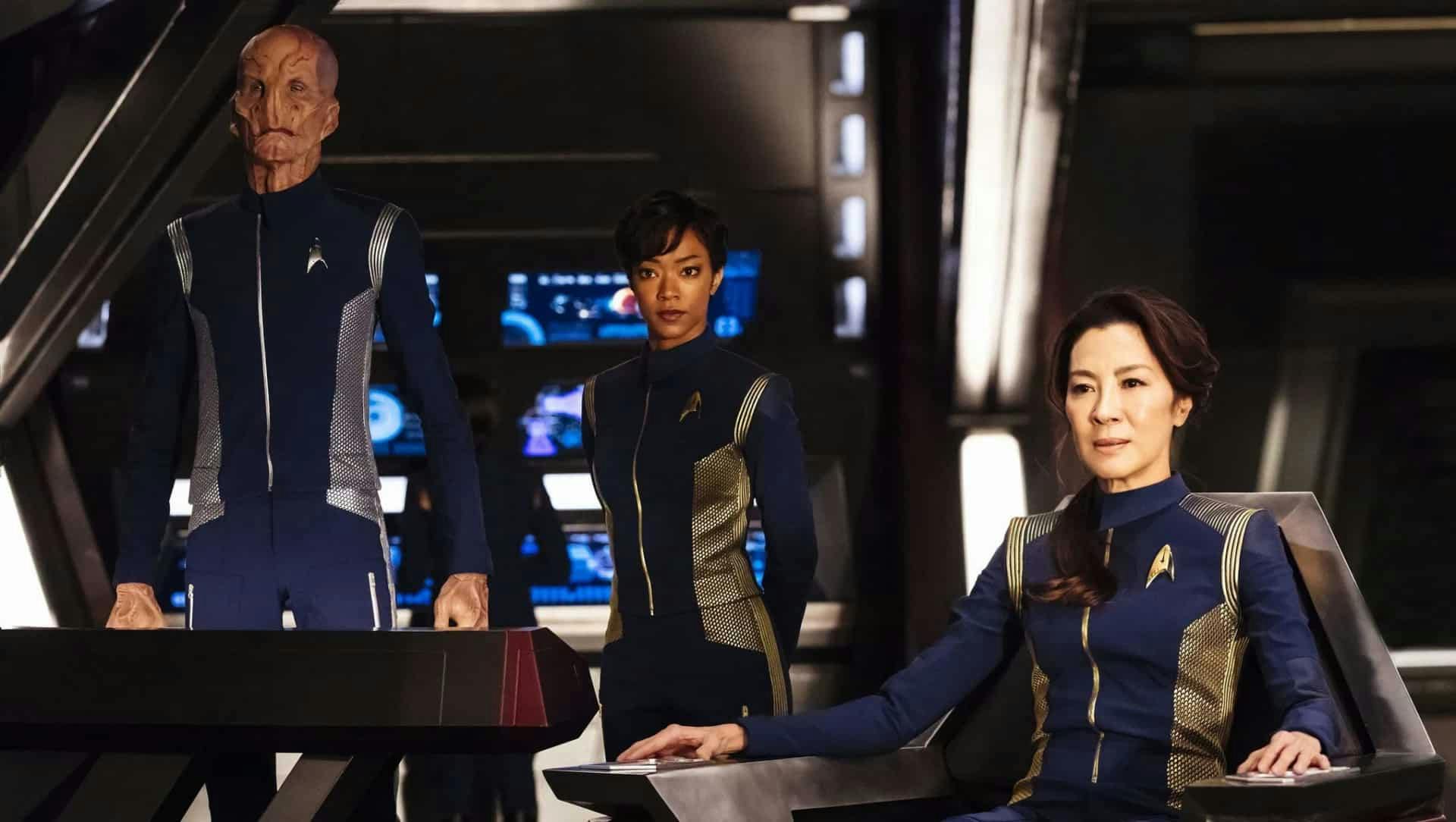
At first glance the Discovery uniforms ignore all previous series. However, there are nods to past series that reveal themselves. While no longer jumpsuits, the jacket, and trouser-leggings of Discovery are blue and thus similar to the Enterprise series. As the series is set between Enterprise and TOS this for me, as a fan, a welcome nod. Most startling is the loss of the iconic red, gold and blue color scheme, it is seen nowhere unless you count the reddish-bronze for Operations. Out of all the series the Discovery uniforms are the most formal. Comparing them to other series, they in fact look like the uniforms of people who have been traveling throughout the galaxy for some time. The form-fitting suit with metal rather than rainbow colors seem to say, “We mean business.” Discovery leans into a militaristic style, more than with previous series. From the rigidity of the jacket to the stripes at the shoulder the uniform appears to, if not welcome , then at least expect conflict and war. The subtle pips on the delta shield could be interpreted to mean that while rank is important, the crew of the Discovery is a family — a band of brothers and sisters equally important and valuable as a captain or admiral. The biggest hint to where this series is going is the asymmetry introduced into Starfleet uniforms for the first time. The eschew collar which creates a delta shape in the front of the face (invoking TOS’ uniform) is closed by a bold metallic zipper that goes from the left of the neck to the center at the jacket bottom. These off-center details could be interpreted to mean that unexpected outcomes are coming!
Star Trek: Discovery (Season 3)
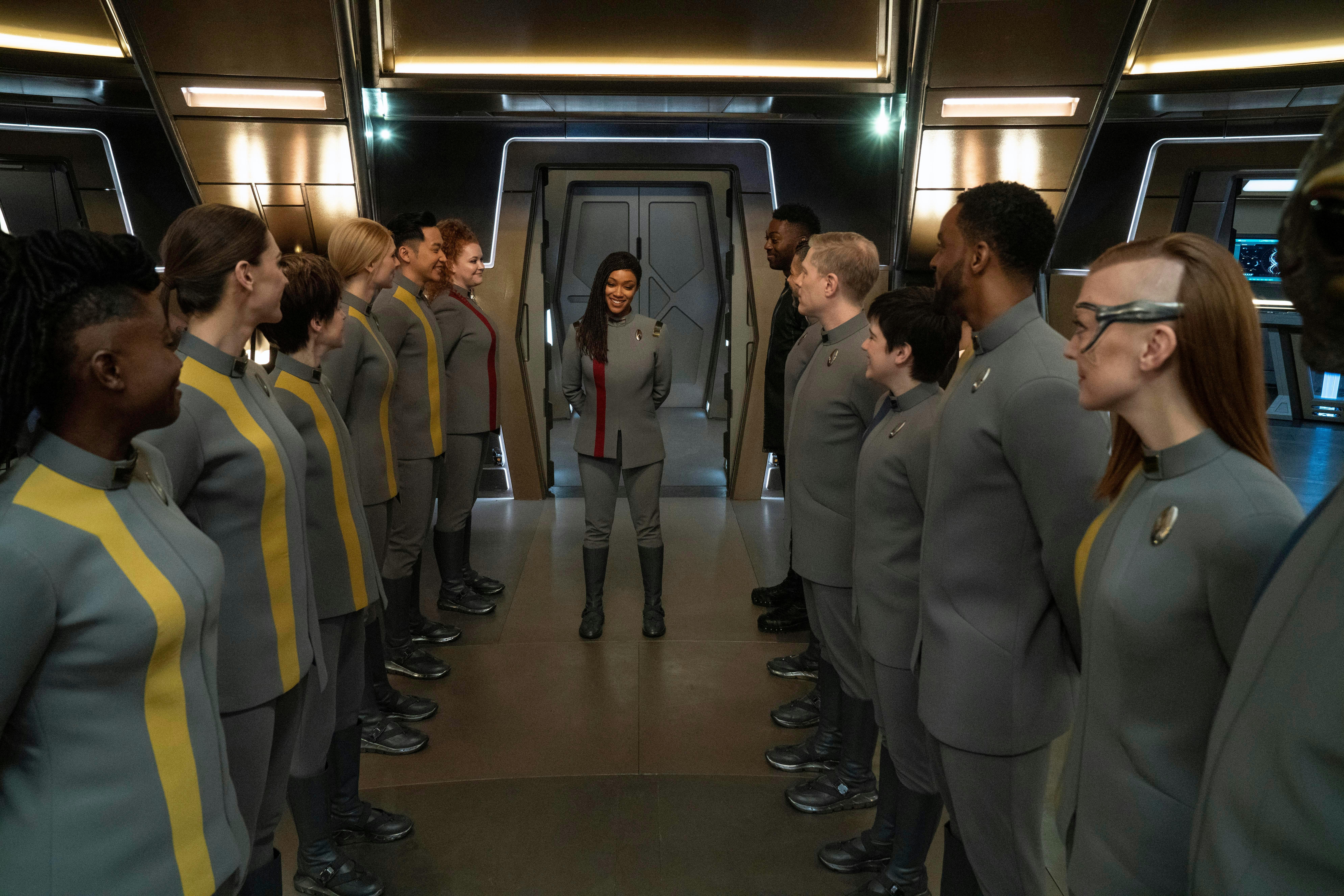
A conversation about Star Trek uniforms would be incomplete without some mention of Season 3’s far-flung future Federation uniforms. It’s not hard to see where these new uniforms took inspiration from other Trek series. In addition to the grey color seen most notably in Star Trek: The Motion Picture , the quilted-ridges at the top of the jacket mirrors that of Deep Space Nine ’s uniforms, and the asymmetry at the bottom of the jacket reminds us of Discovery ’s earlier uniforms. Season 3 even brings back the red, gold, and blue for command, operations, and sciences, this time in a bold sculptural color block down the right side of the jacket. Its appearance seems to state that knowing you and your colleagues’ place in the Federation and on your ship of duty is paramount for rebuilding. This is no time for subtlety. While this same meticulous design could also be overcompensation for the reduction of the Federation’s place, power, and purpose in the 32nd Century it could also be the Federation’s way of “dressing for the job you want (the premiere intergalactic union of planets), not the one you have.” And that’s a tip we can all take with us, to the board room or the Ready Room.
Designer Gersha Phillips Looks Back on Discovery Season 2 Costumes
Bio: Tereneh Idia (she/her) is a writer, fashion designer and fashion educator who has taught and designed in Pittsburgh, New York City, Nairobi, Kenya, Singapore and Bali, Indonesia. While missing out on Star Trek as a child, she expects the rest of her adult growing up to be inspired and entertained by Star Trek.
Star Trek: Discovery streams on Paramount+ in the United States, airs on Bell Media’s CTV Sci-Fi Channel and streams on Crave in Canada, and on Netflix in 190 countries.
Get Updates By Email

IMAGES
VIDEO
COMMENTS
Star Trek uniforms have evolved in color and design over five decades, with gold, red, and blue representing different divisions. The real-life reason for color changes includes costume designers' visions and actors' appearances, with the 24th century seeing a switch in color associations.
Uniforms come in gray, white, gray and white, blue, brown, and beige. The Star Trek delta still remains the symbol for all Enterprise staff members, but the science department's planetary circle and the operations 6-sided spiral are discontinued, replaced with the elongated star.
Learn how the colors of the Star Trek uniforms reflect the characters' roles and rank on the Enterprise. Discover the origin and evolution of the color codes, and the myth behind the red shirts.
Learn how Star Trek uniforms evolved from colorful velour to muted pips and stripes, and what they reveal about rank, department, and fashion history. Discover the behind-the-scenes stories and real-world influences behind the iconic outfits of Starfleet.
In The Original Series, there were three uniform colors. Each color represented a certain duty division aboard a starship or station. Gold, as worn by Kirk and Sulu, denoted the command division...
Fans know the basics: an array of blue, red, and gold shirts line the bridge of the ship every episode. Those colors weren’t just randomly picked for the sake of diversity, though....
Star Trek uniform colors explained. The basic colors that outline Star Trek as a whole are an array of blue, red and gold. These colors line the bridge of the ship in every episode, and relate specifically to the various occupational roles that are performed on the ship.
The Starfleet uniforms featured in Star Trek: Picard's flashbacks were predominantly black with colored shoulders to indicate division, still utilizing the division colors established in TNG, and with the rank insignia still on the collar.
The colors: red, gold and blue. The form-fitting jackets and often black trousers. Even the confining jumpsuits. Star Trek uniforms have a special place in pop culture, equal in renown maybe only by the jerseys and full kits of certain sports teams.
In the original Star Trek series, which ran from 1966-1969 (or roughly from 2254 to 2269, in universe), there were three standard uniform colors among the Starfleet officers on the Enterprise:...